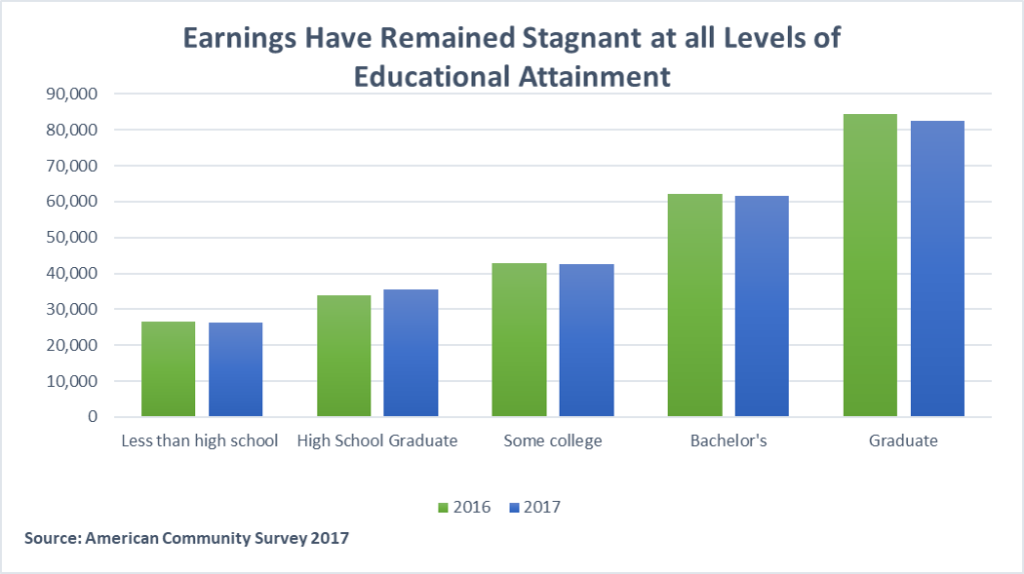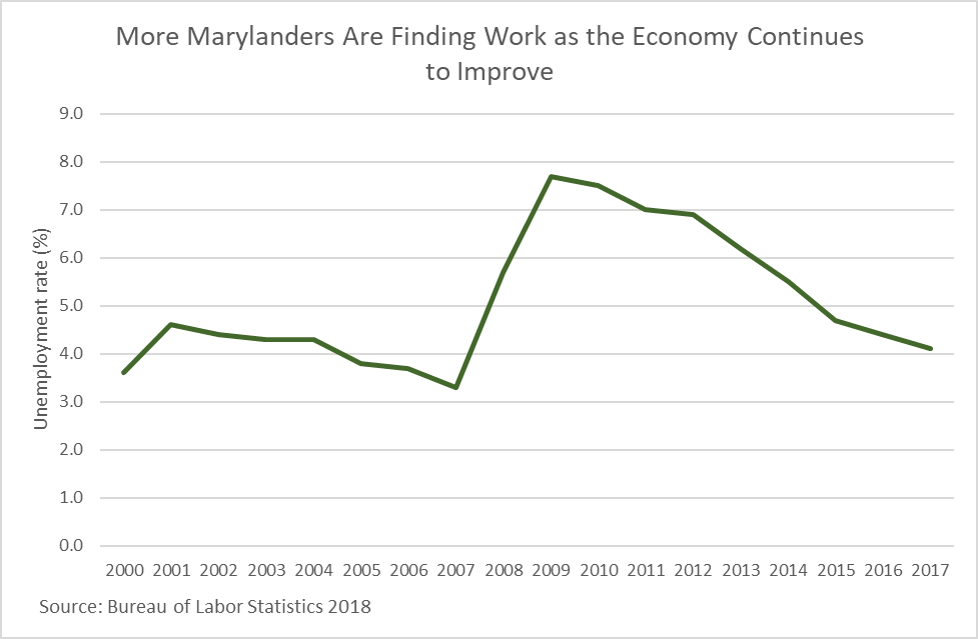Maryland Needs to Invest in Working Families to Support a Thriving Economy
While our state’s overall economy is stronger, a decade after the Great Recession many working Marylanders’ paychecks have not fully recovered from the impact of the recession. Median earnings within Maryland are now 3.1 percent lower than in 2007, after adjusting for inflation. Workers here are now lagging behind the nation, while nationwide median earnings are finally near pre-recession levels, according to new data released last week by the U.S. Census Bureau.
After adjusting for inflation, there was no significant change in wages for the typical Maryland worker between 2016 to 2017. For comparison, wages for the typical U.S. worker rose about 3 percent last year, after adjusting for inflation.
Policymakers can combat the slow wage growth through policies that remove institutional barriers keeping people out of the labor market, increase the minimum wage, and prepare Marylanders for in-demand jobs.
On a positive note, Maryland continues to see a reduction in unemployment. The average annual unemployment rate within Maryland is at its lowest since the recession in 2008. Maryland’s unemployment rate decreased to 4.1 percent in 2017, down from 4.4 percent in 2016. It is also significantly less than the years following the Great Recession, when the statewide unemployment rate peaked at 7.7 percent in 2009.
Not all Marylanders have experienced the economic recovery equally. Unemployment for individuals with less than a high school education is more than double the state’s unemployment rate. Additionally, people without a high school degree have seen their wages decrease by 1.3 percent from 2016 to 2017. Black Marylanders also continue to experience consistently higher rates of unemployment.
This can be partly attributed to the criminal justice system’s disparate impact on people of color. Individuals with low levels of education, as well as people of color, are more likely to have had contact with the criminal justice system. Individuals with criminal records face a multitude of laws, practices, and policies that create major barriers to finding employment once they return to their communities. Limited access to correctional education and job training in prison and time out of the job market with its changing technologies also erodes their job skills. According to one study, hourly wages decreased by 11 percent, annual employment by nine weeks, and annual earnings by 40 percent as a result of time spent in jail or prison.
Maryland has taken steps to reform its criminal justice system within the past few years, but we must continue to work to reduce racial and ethnic disparities and ensure that people can return to work once they complete their sentences. The 2015 Second Chance Act and 2016 Justice Reinvestment Act expanded provisions that removed certain criminal convictions from public records. These measures have reduced, but not erased the impact a criminal record has on a Marylander’s future economic security.
Improving our correctional education programs would better set returning citizens up for success. These programs have been shown to reduce recidivism by as much as 40 percent, with greater gains corresponding with the level of degree an individual obtains.
Maryland currently offers inmates who have a high school degree or equivalent with the option of participating in 23 pre-apprenticeship vocational training programs, as well as a limited selection of post-secondary courses where students can earn college credit at a community college or four-year liberal arts college. As the Workforce Innovation and Opportunity Act allows for increasing funding for correctional education, Maryland should increase funding for correctional education and expand correctional education programming.
In addition, Maryland must continue to build on its past efforts to invest in a educated, skilled workforce and ensure that people who work hard can earn at least enough to afford the basics.
Workforce training programs benefit employers and unemployed individuals alike by helping people gain skills for in-demand jobs. Program expansion accompanied by policies designed to promote wage growth can help Marylanders both find work and increase their earnings. Possible policies include:
- Expand targeted employment programs. Mobile job centers, like those offered in Baltimore City, can bring resources and services to neighborhoods where access is often limited. This allows lower-income residents to access workforce programming and employer services tools designed to help them prepare for employment opportunities.
- Increase the minimum wage. To combat stagnant wages and build greater economic security for Marylanders, the state must continue to build on recent efforts and raise the minimum wage to $15 per hour. Doing so would strengthen Maryland’s economy and lead to increased wages for hundreds of thousands of Maryland workers.
- Increasing public investment in infrastructure. Maryland has seen years of decline in investment in its roads, transit, and public buildings. Increasing our investment in infrastructure would ensure our communities have the public facilities they need while also increasing employment, creating good-paying jobs, and promoting economic growth.
- Expanding the “Ban the Box” employment policy. Due to the stigma associated with having a criminal history, there is often employer discrimination against individuals with criminal convictions. “Ban the Box” makes it illegal for employers to conduct a criminal background check or ask an individual if they have a criminal history before being given an offer of employment. Expanding the policy to include private employers will ensure that everyone has a fair opportunity to work.


